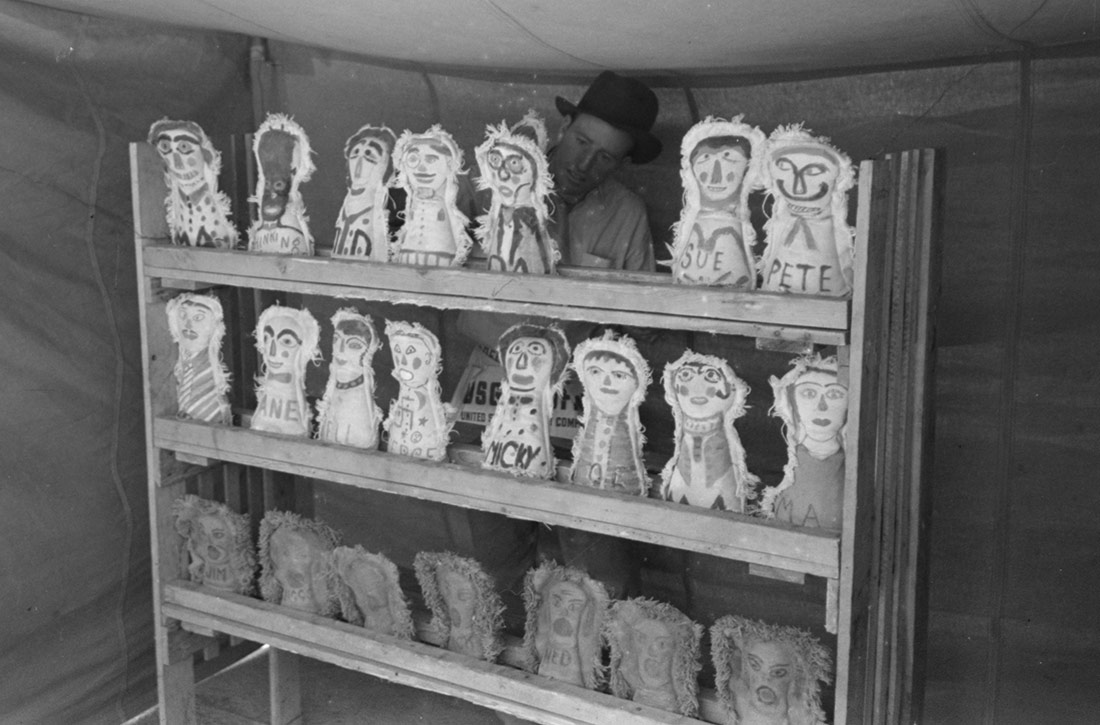
Knocking down dolls at booth at fiesta, Taos, New Mexico, 1940 | Russell Lee, Library of Congress | Public domain
The most paradigmatic example of this burst bubble is the crash in price of the NFT of the first ever tweet. It sold for $2.9 million when released. A year later, last April, an attempt to resell was abandoned when the maximum bid was $14,000. How did this 99% loss of value occur in such a short period?
In reality, NFTs are not dead because they were never alive. No matter how hard you try, when the product itself can be precisely reproduced for free at the click of a button, its only value is the price at which it can be resold.
A great exercise in hyperstition and self-fulfilling prophecy is thus required in order to extract value from the product. In other words, the hype that has been generated around NFTs has been essential in inflating the bubble and allowing some (basically the first) investors to make money. Following the logic of Ponzi schemes, more people need to constantly enter the world of NFTs to stop confidence and growth from stagnating. And in terms of drawing the general public into digital asset investing, the use of emotional suggestion techniques has been essential.
In an attempt to legitimise this format not only in monetary terms, the first tweet sent by the founder of Twitter, Jack Dorsey, was tokenised. This imbued the object with a nostalgic and cultural value. Similarly, tokens of historical memes such as Nyan Cat have sold for millions of dollars. The fact that the value of NFTs is intrinsically linked to the trust in this same value, without the existence of any other official, banking or state structure to support it, means that its credibility needs to be expanded by means of these strategies. The use of references from popular culture serves as a smokescreen – you can make out that you are investing in crypto out of attachment and affection for a certain cultural artefact, pretend that the interest exists out of fetishism for a celebrity, an artist or their work, or camouflage the investments under layers of irony, aware that Bored Apes are nothing more than aesthetically ugly monkeys randomly generated by an algorithm, and that this is precisely what makes them fun. But, as Dan Olson said in the viral video Line goes up, this is not a fandom like the rest, because the product itself is not important, only the profit it generates.
Just as it is essential to have new investors, it is also essential that those who invest do not pull out and sell, because if this were to happen en masse, the value of cryptoart would fall. A supposedly communal atmosphere is therefore generated in which the participants in this great house of cards must constantly convince each other and themselves that they will be rich if they hold out long enough. This story is bolstered by the assertion that this is a select group of visionaries who have been able to jump ahead of their contemporaries and who, thanks to this, will be ushered into the land of plenty and never have to work again. Keeping high expectations of what is to come has become a very important currency and it is essential to constantly keep boosting the hype.
On releasing his own collection, the most famous of all Spanish influencers to adopt NFTs, Willyrex, declared that “Those who trusted will be rewarded! Those who didn’t will flop!” Who knows whether ominously or sardonically.
When first presented to the general public, the intersection between digital art and blockchain was defined as a tool that would allow artists to profit from their work. Even so, the much-heralded democratisation has not materialised, nor has the disappearance of intermediaries. Even less so can we say that this technology has allowed most artists to make money, since the costs of creating and maintaining NFTs are a major obstacle. Not to mention the uneven distribution of sales, which means that very few people actually make money selling their art in this way.
Nor is any of this anything new in the world of commercial art. It is well known that gallery circuits have a tendency to be exclusionary, and to rely on speculation derived from the hype of novelty and the capacity to absorb new trends. NFTs fit perfectly into this logic – the more people agree that an arbitrary object has value, the more value this object will have. However, the art market is not a large enough niche to support the speculative needs of non-fungible tokens.
ARVE Error: src mismatch
url: https://www.youtube.com/watch?v=1XDQnFGEsCw&t=6s
src in: https://www.youtube-nocookie.com/embed/1XDQnFGEsCw?start=6&feature=oembed
src gen: https://www.youtube-nocookie.com/embed/1XDQnFGEsCwActual comparison
url: https://www.youtube.com/watch?v=1XDQnFGEsCw&t=6s
src in: https://www.youtube-nocookie.com/embed/1XDQnFGEsCw?start=6
src gen: https://www.youtube-nocookie.com/embed/1XDQnFGEsCw
The reality is that, above all, NFTs act as an introductory narrative into the world of speculation, far from the stereotypes that are normally associated with it. Brokers are no longer grey, irate guys in pristine suits, inseparable from their briefcases, but rather much more relatable people – influencers, streamers or bloggers. Instead of expert economists (even through there are still endless and complicated technicalities), they are ordinary young guys. The cryptobro, the latest trendy digital tribe, can normally be seen in the minimalist garb of t-shirt, baseball cap and trainers that is so popular among Silicon Valley developers. The cryptobro could be anyone – your neighbour, or even you.
The final frontier of this whole phenomenon seems to be, also, the last hope to refloat NFTs now that their reputation has been severely damaged. As part of the logic of turning every aspect of human culture into a quantifiable and sellable commodity, by means of clicks and statistics, over the last decade we have seen how our actions in cyberspace are increasingly turned into ways of building personal branding. Meanwhile, our jobs have become uberised and gamified. Following this logic, the transformation of play into business is the latest frontier of platform capitalism and the attention economy. Especially through video games.
In order to maintain the exponential growth experienced by the world of video games in recent years, exploitative practices such as crunch culture have been necessary and have given rise to bizarre phenomena such as endless streaming. NFTs look like a new opportunity for expansion that could prevent the recession that is already said to be looming.
The sale of tools, skins, new utilities or downloadable content exclusively for those who pay for it is a growing practice, which has culminated in the creation of what are knows as play-to-earn games. These are video games based on cryptocurrencies, where the action itself matters much less than the possibility of earning money by playing. Major companies such as Epic Games and SquareEnix have supported the tokenisation of aspects of their games through NFTs and the creation of internal economies.
It remains to be seen whether this tactic will set the world of cryptotokens straight and be able to attract new people to the gaming community. During the rise of MMORPGs (Massively Multiplaying Online Role-Playing Games) such as World of Warcraft two decades ago, a shadow economy was created around buying and selling addons and characters, mostly involving workers without rights. At the moment, looking at which states have been the most successful in the implementation of play-to-earn games, which turn out to be precisely those with the most patent economic problems and inequalities, it does not seem that NFTs have led us to any hopeful future, contrary to what some of their enthusiasts were predicting a couple of years ago.





Leave a comment